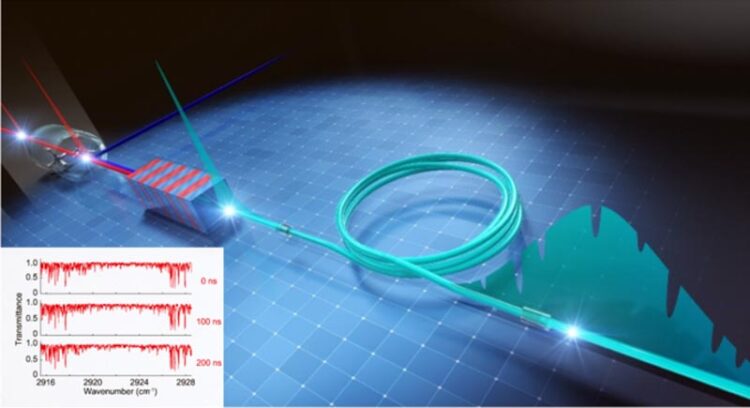Detecting the molecular vibration information faster and better by “stretching” time

First, the sample is illuminated with infrared light. After the light interacts with the sample, the resulting wavelengths are ‘upconverted’ from low-energy infrared to high-energy near-infrared wavelength. The near-infrared pulses then travel through an optical fiber which essentially “stretches” the pulse in time. A near-infrared photodetector detects the pulses. The inset in the bottom left corner shows the transmittance spectra of gaseous CH4 molecules at three consecutive time points.
Credit: Hashimoto et. al. 2023
This ultrafast infrared spectroscopy method would fulfill many unmet needs in experimental molecular science, revealing various high-speed phenomena in detail.
Infrared spectroscopy is a non-invasive tool to identify unknown samples and known chemical substances. It is based on how different molecules interact with infrared light. You may have seen this tool at airports, where they screen for illicit drugs. The technique has many applications: liquid biopsy, environmental gas monitoring, contaminant detection, forensic analyses, exoplanet search, etc.
But the traditional infrared spectroscopy methods provide low (temporal) resolution data. They are usually only applied for static samples because spectral data acquisition is a slow process. Detecting fast-changing phenomena requires multiple quick measurements. Thanks to Prof. Ideguchi and his team at the University of Tokyo, it is now possible to obtain high-speed and high-resolution spectral data. The team discovered the upconversion time-stretch infrared spectroscopy (UC-TSIR) that can measure infrared spectra with 1000 spectral elements at a rate of 10 million spectra per second.
Atoms in a molecule are bound together—like spheres with stiff springs connecting them. Shine infrared light (2-20 µm wavelength) on the substance; it absorbs infrared energy, and the “springs” vibrate. The range of vibrational motions depends on the structure of the molecule. So, we can identify and infer the properties of the substance by detecting the range of wavelengths absorbed by the substance—its absorption spectra.
“With recent improvements in the capability of analyzing spectra using machine learning and other techniques, it is essential for infrared spectroscopy methods to acquire a large amount of molecular vibration information rapidly. We wanted to develop the infrared spectroscopy method to achieve that,” said Prof. Ideguchi, explaining the motivation of the research team.
Conventional time-stretch infrared spectroscopy data has fewer measurable spectral elements (~30) because the instruments work in the infrared region, where optical technology is currently limited. “UC-TSIR breaks the limit by converting infrared pulses containing molecular vibration information into near-infrared pulses with wavelength conversion techniques (upconversion) and temporally stretching and detecting the pulses in the near-infrared region,” said Dr. Hashimoto. Compared to conventional methods, UC-TSIR provides over 30-fold more spectral elements and 400 times better spectral resolution. The UC-TSIR can trace high-speed phenomena such as the combustion of gaseous molecules and irreversible chemical reactions of biomolecules at a high temporal resolution.
In theory, the concept sounds simple and easy to implement; but it was far from that. “We carefully selected optical elements and adjusted the parameters through trial and error. Even after building the setup, we dealt with various spectral distortions caused by unwanted nonlinear optical effects and insufficient time stretching. We were overjoyed when we finally saw clear infrared absorption spectra after dealing with those issues,” said Dr. Hashimoto. “Nanosecond- or microsecond-scale ultra-fast continuous infrared spectral measurements by UC-TSIR can solve problems unresolved by conventional spectroscopy methods.”
Related links
School of Science, The University of Tokyo: http://www.s.u-tokyo.ac.jp/en/
Ideguchi lab: https://takuroideguchi.jimdo.com/
Journal: Light Science & Applications
DOI: 10.1038/s41377-023-01096-4
Method of Research: Experimental study
Subject of Research: Not applicable
Article Title: Upconversion time-stretch infrared spectroscopy
Article Publication Date: 3-Mar-2023
All latest news from the category: Process Engineering
This special field revolves around processes for modifying material properties (milling, cooling), composition (filtration, distillation) and type (oxidation, hydration).
Valuable information is available on a broad range of technologies including material separation, laser processes, measuring techniques and robot engineering in addition to testing methods and coating and materials analysis processes.
Newest articles

NASA: Mystery of life’s handedness deepens
The mystery of why life uses molecules with specific orientations has deepened with a NASA-funded discovery that RNA — a key molecule thought to have potentially held the instructions for…

What are the effects of historic lithium mining on water quality?
Study reveals low levels of common contaminants but high levels of other elements in waters associated with an abandoned lithium mine. Lithium ore and mining waste from a historic lithium…

Quantum-inspired design boosts efficiency of heat-to-electricity conversion
Rice engineers take unconventional route to improving thermophotovoltaic systems. Researchers at Rice University have found a new way to improve a key element of thermophotovoltaic (TPV) systems, which convert heat…



